Cost Comparison: Traditional Survey vs Machine Control
Using four highway construction projects, this article compares the costs of traditional survey methods and machine control methods to demonstrate a conservative 80+% survey budget saving for projects that choose to utilise machine guided construction.
Published: 20th June 2012
Author: MachineGuidance.com.au

Introduction
Introduction
The following paper uses four highway construction project case studies to compare the costs of traditional survey stakeout methods against machine-control guidance methods. Specific project names have been kept confidential in this paper.
Project A and Project B refer to two highway construction sites that relied completely on traditional survey methods with no machine-control guided plant used during construction. Project X and Project Y, also highway construction projects, refer to two alternative projects that both relied heavily on machine-control guidance rather than traditional survey methods.
Project A has been used in this paper as the control site for traditional methods. This site has also been compared against the traditionally-surveyed Project B to confirm that the control site assumptions are consistent.
No two construction sites are the same and comparing the four projects is a considerable challenge. However, all efforts have been made to accurately and effectively account for the full requirements of both traditional survey and machine- guidance methods.
In order to provide an accurate comparison the project budget on the Project A control site is adjusted for inflation from 2000 to 2008. The control site project budget and survey requirements are then compared to the machine-control comparison sites to determine a realistic requirement of survey personnel if these projects had proceeded with traditional survey stakeout methods.
Upon comparing the estimated traditional survey costs against the actual machine-guidance costs on both Project X and Project Y, both projects demonstrate an 80-88% cost saving by utilising machine-guidance. This does not take into account other considerable cost savings achieved through the elimination of grade checker personnel requirements or the costs recovered through asset hardware sales at project completion. The cost benefits achieved through machine guided construction could also be increased with the inclusion of less-tangible savings such as reduced loss-time-injury, less field downtime, less double-handling of material and reduced staff turnover.
It is therefore concluded that construction sites with significant survey requirements and project budgets to suit should seriously consider the cost benefits associated with utilising machine guidance methods of construction.
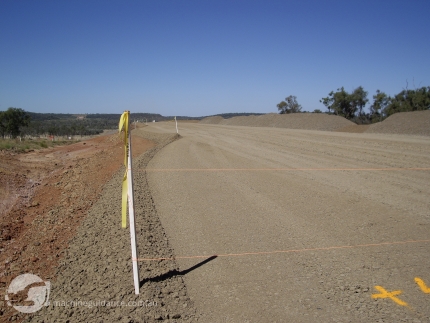
Image - Traditional Survey
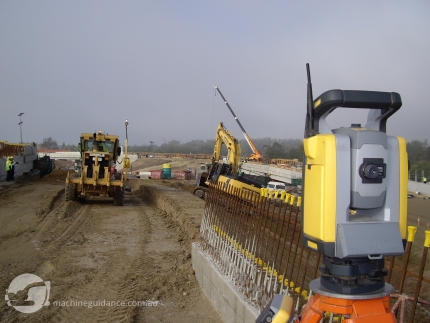
Image - Machine Guidance

Project Backgrounds
Traditional Survey Projects
Project A
Project A, constructed in 2000-01, was a $50 million, 5.5km highway construction job located in Northern NSW. The project involved a new alignment running through open paddocks connecting to existing motorway at both ends and included 5 major bridge structures.
The survey requirements on the project involved 6 survey personnel including 3 senior surveyors and 3 survey instrument hands. There was no machine-control equipment used on this project. The site relied completely on traditional survey stakeout methods.
Project A is the most recent site that the authors of this paper were involved with that was surveyed completely without the use of any machine control. For this reason, the project will be used in this paper as the control site for traditional survey methods.
Project B
Project B was constructed in 1998-2000 and consisted of 12km of highway construction, 11km of service roads, 5 major bridges and 4 interchanges. The project was valued at $130 million.
The survey requirements on this job included 7 field crews and 2 office surveyors, bringing the total survey personnel to 16. There was no machine control equipment used on this project with the site relying completely on traditional survey methods. As such, this project provides a good comparison for the base assumptions of traditional survey methods derived from Project A.

Machine Control Projects
Machine Control Projects
Project X
Project X, constructed in 2008-10 was an $840 million highway upgrade job. The project involves 7.6km of multi-lane motorway, new interchange, new rail formation, 5km of service roads and 26 bridge structures. All work was carried out in confined spaces in a manner that maintained existing traffic flow and reliability. This resulted in relatively difficult site access and comparatively difficult survey visibility.
The survey requirements on the job involve 20 survey personnel including 7 surveyors and 8 instrument hands. There are also 22 GPS / total station guided machinery using state-of-the-art guidance systems, 7 GPS Supervisor Car Kits and 3 GPS Rovers dedicated to on-site Engineer crews. The site relies heavily on 3D machine guidance methods rather than traditional survey stakeout. This paper will compare Project X site to the traditionally-surveyed Project A site.
Project Y
Project Y, constructed in 2007-09, was a $195 million highway construction project located in the western suburbs of Brisbane. The job involved approximately 14km of dual carriageway running through green fields (no existing roadways to connect with) and included 6 bridges and 2 major roundabouts.
Project Y employed the use of 3D guidance on 8 machines (including GPS, laser and total station guidance) as well as 2 GPS Supervisor Car Kits. Project Y also employed 1 Survey Manager, 1 survey crew dedicated to bridge structures and 3 single-man earthworks crews. The site relied heavily on machine guidance rather than traditional survey stakeout. This paper will use Project Y as an additional comparison of machine control methods and traditional survey methods in order to qualify any findings.

Comparison Methodology
No two construction sites are the same, which makes comparing survey methods on different sites a considerable challenge. In this comparison, all efforts have been made to accurately and effectively account for the full survey requirements of both traditional surveyed sites and machine guidance sites. Consumables have not been included in the comparison both because of the difficulty of estimating their worth and because it is assumed that they will offset each other across both construction methods - i.e. the cost of survey stakes, paint, ribbon, etc is offset against replacement of machinery control equipment cables, sensors, etc.
Estimates of site survey requirements have historically been calculated using project budgets. In a further effort to maintain the integrity of this comparison, the project budget of the traditionally-surveyed control site (Project A) has been adjusted for inflation since 2000. Using official Reserve Bank of Australia statistics (see Appendix A of the downloadable article) an average annual inflation figure of 3.15% has been added to the $50 million Project A budget to increase the controlled site to $66 million in 2008 (commencement date of comparison machine control Project X). Similarly, the project budget for the traditional surveyed Project B has also been CPI-adjusted using the same inflation figures. This $130 million project budget has been increased to $177 million. Details of these budget adjustments can be found in Appendix B of the downloadable article.
The adjusted figures used in the comparison are outlined below, along with the total survey and machine-control usage for each of the four case study projects.

Comparison Methodology (2) with Image

Comparison: Project A vs Project B (Traditional vs Traditional)
Survey Requirements
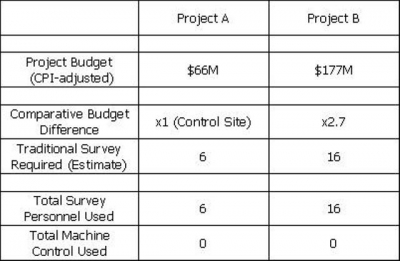
Survey Requirements
Survey Requirements
Using CPI-adjusted project budgets for both projects, we can compare the traditional survey required on the Project A control site against the traditional survey used on the Project B site. This will allow us to confirm the assumptions made for the control site.
The conventional method for determining survey requirements have historically been calculated using project budgets as a guide for the number of survey personnel required on a project. At $177 million, Project B was 2.7 times bigger than Project A. As Project A using no machine-control required 6 survey personnel, we can determine that Project B, also using no machine-control would require 2.7 times more people; 16.2 survey personnel.
The survey requirements on Project B included 7 two-man field crews and 2 office surveyors; 16 people all up. The conclusion made from this is that using Project A as a control site for traditional survey requirements with no machine-control holds true to other traditionally-surveyed projects.

Comparison: Project A vs Project X (Traditional vs Machine Control)
Traditional Survey Costs
Using the $840 million Project X budget and the CPI-adjusted $66 million Project A budget, it is evident that Project X was 12.7 times bigger. We can therefore extrapolate that using traditional survey stakeout methods, 12.7 times as many survey personnel would be required on the Project X site in order to survey the job by traditional methods rather than using the current machine control.
As the Project A employed the use of 6 survey personnel (3 survey crews), a traditional Project X site would require 76 survey personnel (38 survey crews).
As the machine control guided Project X site did employ 20 survey personnel, a further 56 people would be required. This equates to an extra 28 two-man field crews.
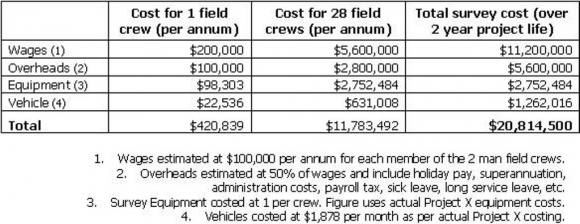
Image - Traditional Survey Costs - Project X

Additional Survey Cost Considerations
Additional Survey Cost Considerations
- Costs above do not account for survey stakes, paint, ribbon, etc required for survey stakeout.
- Costs above do not include hardware or wages for grade-checkers that would be required to use the survey stakes for string-lining. Grade checking using survey stakes and stringlines is traditionally a three man job.

Machine Control Costs (Heading)
Machine Control Costs
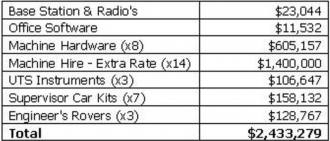
Machine Control Costs (2)
Machine Control Costs
The table outlines the actual expenditure by Project X on all machine-control related products. This includes office software, base station hardware, machine hardware, total station instruments dedicated to UTS graders, supervisor GPS car kits and GPS Rovers used by field engineers for reference.
A cost for additional hire rate of $20 per hour (estimated by Project X Logistics Department) has been included for each of the 14 machine-guidance plant that were hired by Project X. This additional hire rate has been multiplied for a 50 hour week and 50 week year over the 2 year length of the project.
Additional Machine Control Costs
- Costs above do not account for machine control wear and tear items such as component cables, replacement sensors, etc.

Project Savings
Project Savings
The below table compares the estimated traditional survey method cost and current machine control costs and outlines the projected project savings. Using machine control guidance on Project X saved $18.4 million or 88% of a traditional survey budget.

Project X Savings - Image

Comparison: Project A vs Project Y (Traditional vs Machine Control)
Traditional Survey Costs
Using the same methodology as that used above to compare Project X, the following compares the Project Y machine-control site against the traditionally-surveyed Project A. Project Y budget was three times the size of Project A and therefore estimates suggest they would have required 18 survey personnel (or 9 crews) if using traditional survey methods.
As Project Y actually used 6 survey personnel, an extra 12 personnel (6 crews) would have been required if the site used traditional survey methods. Using the same information as used for the Project X, the following table outlines estimated traditional survey method costs that would have applied on Project Y.
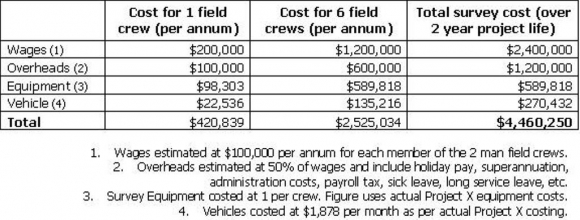
Image - Traditional Survey Costs - Project Y

Additional Survey Cost Considerations
Additional Survey Cost Considerations
- Costs above do not account for survey stakes, paint, ribbon, etc required for survey stakeout.
- Costs above do not include hardware or wages for grade-checkers that would be required to use the survey stakes for string-lining. Grade checking using survey stakes and stringlines is traditionally a three man job.

Machine Control Costs (Heading)
Machine Control Costs
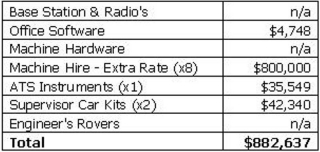
Machine Control Costs (2)
Estimated costs for machine guidance and related products on Project Y are tabled. Note that on this project, no extra base station radios were required to utilise machine control and no engineer rovers were used. Additionally, all machine guidance plant was hired to this site with no hardware cost to the project.
As for Project X, an allowance for additional hire rate of $20 per hour (estimated) has been added for each of the 8 GPS-guided machines hired on Project Y. This extra hire rate has been multiplied over a 50 hour week and a 50 week year over the two year length of the project.
Additional Machine Control Costs
- Costs above do not account for machine control wear and tear items such as component cables, replacement sensors, etc.

Project Savings
Project Savings
Using the same methodology as that used for Project X, estimated costs for traditional survey methods are compared with machine control costs and the project savings are outlined below. Using machine guidance on Project Y saved $3.5 million or 80% of a traditional survey budget.

Image - Project Y Savings

Additional Project Saving
In addition to the survey cost benefits mentioned above, the following points outline further project savings that can be achieved through the use of machine control technologies over traditional survey methods.

Field Labour Cost Savings
Field Labour Cost Savings
Replacing traditional survey stakeout methods with machine guided construction eliminates the requirements for field grade checkers. On a traditional construction site, surveyors peg the intended design at regular cross-sections. Grade checkers are then responsible for determining the design cut/fill by string-lining between the pegged cross-sections. As machine control puts the design inside the machine cab, grade checkers are not required on a machine-control guided construction project.
Grade checking for an excavator is traditionally a one-man job, while grade checking for a grader is traditionally a three-man job. As an example, on our case study Project X a total of 9 machine-control excavators and 8 machine-control graders were utilised, none of which required traditional construction grade checkers.
Without 3D guidance, an extra 9 grade checkers would have been required to service the excavator operations and a further 24 grade checkers would have been required for grader trim operations (8 graders x 3 grade checkers each = 24 extra personnel). A total of 33 grade checkers would be required on the Project X case study site if it was to be traditionally surveyed. Using the same estimated costs for wages and overheads as survey personnel and a 2 year project life, this equates to $9,900,000. Not requiring grade checkers on-site saved Project X almost $10 million.

Image - Grade Checker Costs
The absence of field grade checkers when using machine guided technologies represents a significant project cost saving.

Recoverable Hardware Sales
Recoverable Hardware Sales
An often overlooked aspect of machine guidance methods are recoverable costs due to asset sales. Assuming that the project purchases the machine control hardware (as was the situation in our case study Project X) then these assets are able to be sold at the completion of the project.
Our case study Project X was able to sell their project-owned assets at the completion of the project. Based on conservatively-estimated market values at the time, Project X recovered a total $598,314 by selling their machine control and related hardware at the project's completion. This effectively reduces the cost of machine guided construction making it an even more cost-attractive option.

Less Tangible Project Saving Considerations
In addition to the hard dollar project savings mentioned above, the following points outline possible additional savings that could arguably be contributed to the use of machine guidance.
- Reduced Loss Time Injury (LTI): As using machine-guidance reduces the need for on-the-ground survey set-out and field crew string lining, there is less opportunity for workplace injuries involved with these tasks. This includes the typical manual-labour injuries associated with using sledgehammers and stringlines. This also includes the particular safety concerns that are specific to modern day construction sites including confined work spaces and large quantities of heavy vehicle movements (moving material across live motorways using truck and dogs). Therefore it could be argued that reduced LTI and the associated insurance costs is a project saving associated with using machine control guidance over traditional survey methods.
- Less Downtime: As all information is available to both field supervisors and machine-control operators, there is no need to wait for survey set-out. This is particularly true of unplanned works that can be commenced (if not completed) without waiting for survey by using machine guidance. It could be argued that using machine guidance reduces machine and field downtime.
- Less Double-Handling: Because all information is available to field supervisors and machine operators, the full extent of designs is known in the field. This also assists with on-site planning of basic infrastructure (such as haul roads, compound locations and temporary drainage requirements) which can be better positioned by instantly knowing the full design extents. It could be argued that using machine guidance reduces double-handling of material.
- Reduced Staff Turnover: As field staff and machine-guidance operators have more involvement with the project, they are taking more pride and ownership of their sections of the job, making a more valuable employee. Similarly, as survey crews are performing less of the manual and repetitive task of pegging, they too are able to move on to more satisfying tasks. It could be argued that using machine guidance results in less staff turnover and the costs associated with this.

Conclusion
Using CPI-adjusted project budgets and accounting for the full survey requirements of both methods, this paper has compared two traditionally-surveyed projects against two machine-control guided projects. Based on the Project A control site, estimates of required survey personnel have been costed and compared against actual machine control costs.
Despite the up-front expenditure on machine guidance products, using this method against the traditional survey stakeout method conclusively results in considerable project savings. Analysing all relevant survey and machine control costs across two separate construction projects has demonstrated an 80-88% saving by preferencing machine control over traditional stakeout survey. This excludes the additional cost benefits achieved by reduced field labour requirements or the costs that can be recovered by selling project-owned machine-control hardware (where applicable) at the completion of construction.
It is therefore concluded that construction sites with significant survey requirements and project budgets to suit should seriously consider utilising machine guidance methods of survey. While it is true that some traditional survey will always be required, a construction site of worthwhile size would almost certainly benefit from heavy utilisation of machine guidance methods

Image - Conclusion

Back to Articles


